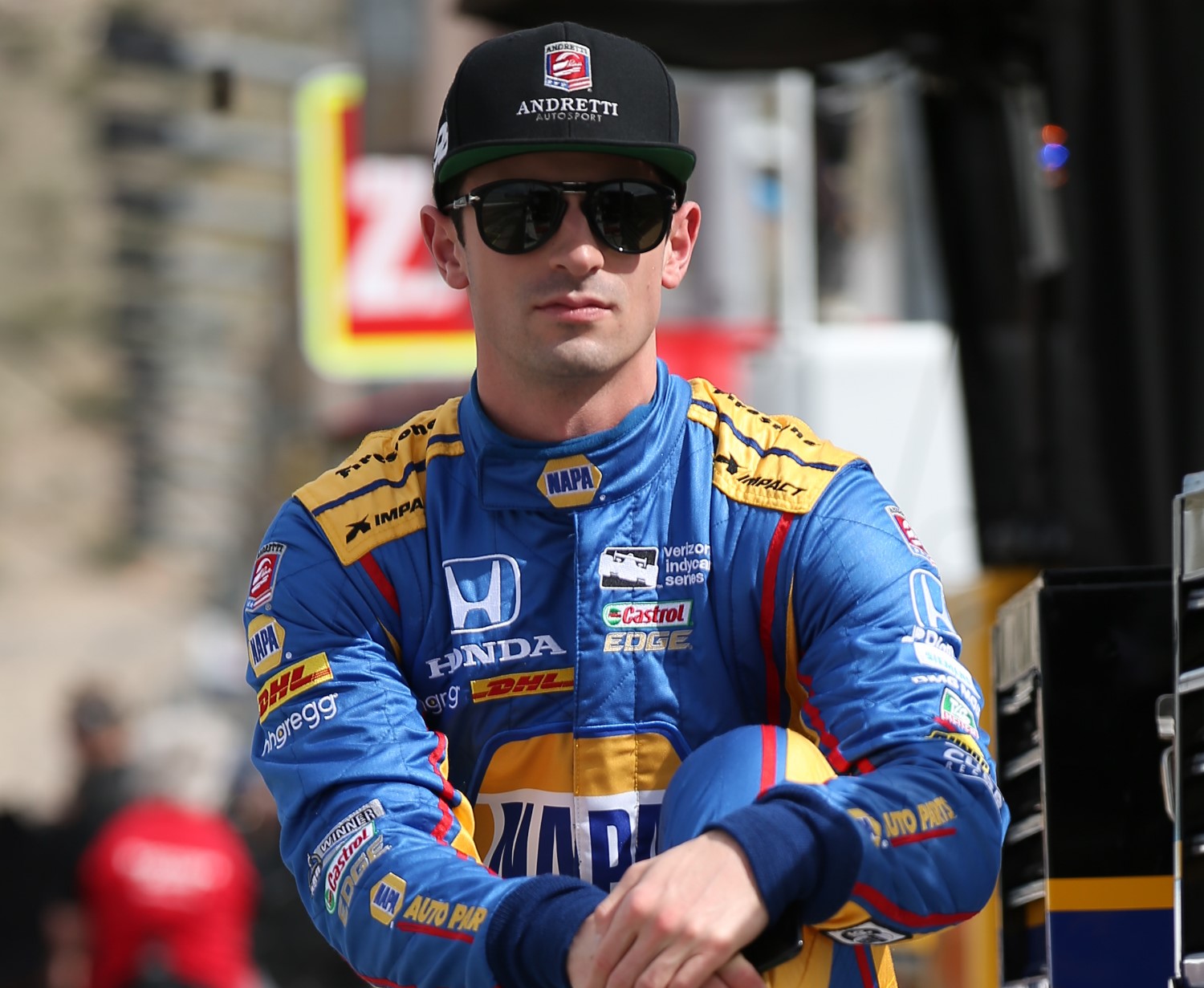IndyCar Phoenix Test Friday Press Conference
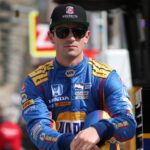 |
| Alexander Rossi waits as his crew prepares his car |
An Interview
Marco Andretti
Alexander Rossi
Ryan Hunter-Reay
Takuma Sato
Scott Dixon
THE MODERATOR: We will continue with our Verizon IndyCar Series media availabilities for the weekend. Joined now by the group from Andretti Autosport: Ryan Hunter-Reay, Alexander Rossi, Takuma Sato and Marco Andretti. First day back on track for the series open test. What were your thoughts from the first session?
MARCO ANDRETTI: Yeah, early days, but great to be back. Great to be driving again. Great to be at Phoenix, good weather. Yeah, I mean, just still early. It's too early to tell about anything. Probably these two days will still be early as hell, but good so far, steady, really having fun working with Bryan (Herta), and even having Eric Bretzman there has been a good addition, as well. So far, so good. It's been fun.
THE MODERATOR: Speaking of team changes, joining us this season at Andretti Autosport is Takuma Sato. Talk about that transition to the team and the general impressions of the team so far.
TAKUMA SATO: Very happy. Very happy day, I think. Like Marco said, it's a very arid day, but jumping in a car, you need to feel comfortable, having said that, I've been out of the car for over five months, and five months has obviously felt long, but it's a transition for the team, a lot learned, and to meet the people, went to the shop and to go through a lot of stuff with engineers and et cetera, et cetera. Just like one click and then now jumping in the car, so I was happy, and obviously those strong three other teammates helped me out really well for the first session. The car is there already. We went to the very low profile to start with, and I really need to build up the confidence because I didn't have a very good memory here last year. But the car worked really well and happy where I am today, and I'm excited about the season.
THE MODERATOR: Alexander, you were here just last week talking about the new renovation project here, and we mentioned while we were there that this was your first oval here in the Verizon IndyCar Series. Now that you're on track again for this open test, how valuable is that time leading up to the ovals coming up for the 2017 season?
ALEXANDER ROSSI: Yeah, it's great. I mean, every time on track here, you're always learning. But yeah, it's a much different experience for me now this February than it was last February, no doubt. I kind of knew a little bit what to expect and wasn't as worried last night, if you will. But yeah, I mean, I think that the team is — obviously we have a big challenge in front of us this year to kind of redeem ourselves, and I think that the atmosphere is good and we'll keep working away each day and try and deliver.
THE MODERATOR: Joined also by Ryan Hunter-Reay. Obviously everybody just got on track for the first time. Very much a first day of school type of atmosphere. What are these tests like when you see everybody on track to preview the season?
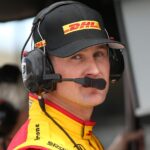 |
| Ryan Hunter-Reay |
RYAN HUNTER-REAY: Yeah, you know, it's just nice to get back to work, really. This is what we do. You know, this is how we operate. This is how we operate mentally, and being away from the racetrack you kind of feel like a fish out of water, so it's nice to be back and just be back into it, be back into the rhythm. I wish we were here for a race weekend or something just so you could be in this more. The test is going to fly by, but we have four cars, we're going to work together as we always do at Andretti Autosport. We're going to put together the best race car, come back with it, and hopefully make for an interesting race when we come back for the Phoenix race weekend.
Q. Alex, it's pretty close to the one-year anniversary where you signed your deal to run an IndyCar. Have you ever given yourself a chance to sit back and reflect on what that year has been like for you?
ALEXANDER ROSSI: Not really. All of y'all have kept me so busy during the off-season.
But it's been a super positive experience for these 12 months. I feel like I've found a new home here, and I'm very happy to continue that and be a part of this organization and this team and go to work with these three guys next to me.
Q. Ryan, I'll start with you. I'll give Alexander a pass on this question because he and I talked about this when he was here for the PIR announcement last week. We all remember every bad thing luck-wise that could remember to you in this race last year happened, but in the spirit of trying to build this event in this market, there was a lot of talk after the race last year about it was hard to pass, the groove was narrow, maybe too much downforce, but the talk not necessarily from you but in general was that it was the first year back, we can do better. With the aero kit freeze and so forth, are you confident that the showbiz value of the race will be significantly better than last year?
RYAN HUNTER-REAY: Our first objective as a series, but mostly as drivers, is to make a better show for the fans. It's better for us. It's more fun for us. When it's more entertaining for you, it's fun for us, and we wanted to do something. When we have a last year when it takes 30 laps to pass a car, it becomes frustrating and we know that that's not what the fans come here and want to see. Even though in the car, it's extremely difficult, and you have to think every move out, I'm not really sure yet where that's going to pan out, and what the changes — it's an aero freeze year, so we're kind of in between a development year, and we're going to come back with a universal kit basically where everybody is on the same kit, and that may be a different race entirely.
I can't really say that yet. We're going to go out there, we're going to run together tonight, tomorrow, and we'll have a better idea. We came back here testing some aero stuff. I can't really say there's a silver bullet at the moment that's been implemented.
Q. Alexander and I talked about (No microphone.)
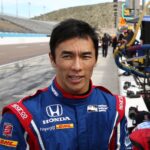 |
| Sato |
TAKUMA SATO: I think it's hard to tell. Like Ryan described, the aero freeze, fundamentally we had nowhere to go compared to last year. Obviously the Honda package this time last year, it was just introduced the second generation with the road course package, and then Phoenix obviously the engine package was getting stronger throughout the season. Having said that, so does the competitors, and we really don't know how it's going to show up. We will see this afternoon or night session how it's going to be. But I predict it will be extremely difficult to pass here again, and I don't see there's being a big change from last year, if we decided to leave the rule as it is.
Q. (No microphone.)
MARCO ANDRETTI: I'd like to think so. You know, we're going to work on it. We've been pushing it. That's for sure. All I can say is the only thing that I think can help is just closing the holes up on the bottom of the floor. But that's just me.
You know, I think other than that, I mean, it's just going to be tough to say how it's going to play out. It's so early, even here. Who knows if the manufacturers have made gains since last year here. I'm sure they have, both of them. We'll see when it's all — when everybody has turned up.
RYAN HUNTER-REAY: Firestone is bringing back a slightly different tire, which could affect the racing. Sometimes they're the most powerful player in that game, as well.
Q. Is that true?
RYAN HUNTER-REAY: : It is, yes. It's a different tire, but we don't know what that's going to do to the racing yet.
THE MODERATOR: We'll bring you all four back in tomorrow after the night session so you can tell us if the night session proved to be different. How about that? (Laughs.)
Q. This is your first chance to really have a blend of teammates with this much success and this much veteran leadership. How beneficial is that for you and how enjoyable is that for you coming into the season?
[adinserter name="GOOGLE AD"]TAKUMA SATO: It is for sure beneficial. We have seen that in years and years at Andretti Autosport is working extremely competitive throughout the season because of the driver lineup and the way they operate the team. Now obviously I could see why they could do that. It's a very sophisticated engineering program. Those drivers share the data, which we haven't done — we just finished up the session 15 minutes ago, so I really haven't seen any data next to the three drivers.
But I think it will be fun. It will be fun to enjoy, to work together and to make the team move forward, and that's our only objective at the end of the day. I think this is a great opportunity for me to work with this foundation and organization. I'm extremely excited about it.
Q. Marco, we're seeing you smile for the first time in a long time. I know it's only been one session, but just talk about how important it is to just have Bryan in your ear and just how much you're enjoying working with him.
MARCO ANDRETTI: Oh, Bryan, yeah. Yeah, it's — I don't know, I just think it's a good change-up. I think one thing about my dad and I is we're both very loud on the radio, and that's just always how we operated, and we're fine operating like that, but sometimes people around us aren't. Bryan is very good at keeping me focused on the 27. How can we maximize the 27. And then it's very easy to be, oh, Penske went this fast, or oh — we need to focus on what we can do to go faster because it's not the elements we can't control, and I think that's a good addition to — a good mindset change, anyway, for us.
Q. Just to follow up on that, Ryan, do you take anything from this time sheet at all? I know being towards the front is better than being last, but do you take anything out of this?
RYAN HUNTER-REAY: No, it's funny, I was walking back from this first session back to the transporter, and I'm thinking, man, I've been around for a little while, I've done this for a while, and I know better than to get excited about first session times. It's a long ways to go. When we come back, the picture will change. Really, like Marco was talking about, what you have to do is you just focus on your own car. It's just like you're here by yourself testing, and your teammates, and we're just going to operate in our own little bubble and not really worried about where anybody else is because people are on different trim levels, people are up and down on engine power, people are getting toes, some aren't. Everybody is on a different tire program, tire life, you name it. So we're just going to stay on our end and focus on it, and like I said, try and bring back the best race car that we can.
Q. (Question about the weather.)
RYAN HUNTER-REAY: We would prefer it to be a little bit hotter because it will be more resemblant of what we're going to come back and do, but this is nice. Not complaining.
Q. Alexander, for you, having Jeremy as an engineer is new, but he had a lot of success on the short ovals last year. How excited are you to have him here and for the rest of the season?
ALEXANDER ROSSI: Well, I'm pretty excited about Iowa. I think we all are, to kind of have that bit of information. But no, Jeremy has been awesome from day one of working with him at the one Sebring test we did, we were kind of up to speed with each other right away, and we've done some work in Indy together. I mean, it's been pretty seamless transition. We're still kind of trying to learn each other's likes and dislikes, but it's the first session and it wasn't terrible. It's been really positive having Rob Edwards as strategist on the radio is also fantastic. If Bryan is going to go to Marco, I think Rob is probably the best replacement in the year. I'm really happy with the team I have right now, and hopefully we can continue to move forward and develop ourselves.
Q. When you arrived at Andretti Autosport, what was the biggest thing that struck you? What was the biggest eye opener because it is one of the big teams in the series, you're working with a couple of teams that were smaller in nature in your career in IndyCar, but what was the first impressions like when you came to Andretti?
TAKUMA SATO: I mean, kind of expected. It's nothing really surprised me, like to talk about — I've been in a big team in the Formula 1 world with 600 people working on one factory, so you imagine compared to that, IndyCar is more like really tight family.
But I was in Texas (AJ Foyt Racing) for a long time, and it was a very nice, warm team, but in terms of number of people working, it's extremely narrow and small numbers. Now of course we went to Andretti, not only for the IndyCar program but working with the Indy Lights program and all the others all together, close to 100 people all together. It's difficult to remember the name who you're working with, passing the people, say hello, it's difficult to remember right now, but it just feels good. The very strong engineering, that's what matters, and those boys are the same. Boys have been boys all the time. Every mechanic is fantastic, so I'm happy to be working with a big team.
Q. And Ryan, when you have a driver that's been on another team that you've raced hard against and maybe a time or two have come together and now —
RYAN HUNTER-REAY: Us? No. When?
Q. Pocono. And then now that he's a teammate, I mean, at one point or another you're going to probably work with most everybody that you've raced against. What's it like to have Takuma as a teammate?
RYAN HUNTER-REAY: Takuma has so much experience. He knows what he wants from a car. He's one of the fastest guys out there, and with those two combined, we're looking forward to adding him to our mix, to our debriefs, to our development and our progression. I think he's a great add, and a big part of the Honda family, as well. It's good. I think we're going to work well together. I think all of us work well together just like I keep saying at Andretti Autosport. We do work as one big group, and communication is number one. We're going to continue down that way.
Q. You were referring to the tow around here. How much do you gain in terms of tow when you then play it off against how much you're losing behind someone in the turn in terms of washing up?
MARCO ANDRETTI: I mean, you lose more in 1 and 2 as far as losing the front in traffic, but then, yeah, the tow, as soon as you get out of 1 and the car is straight, you want to see somebody ahead of you all the way through, all the way until you enter again. So I'd say just Turn 1 is not good, but everywhere else is good.
RYAN HUNTER-REAY: If you get like a two or three-second tow on newer tires, you can just keep going. It could be worth, what, two tenths, three tenths, something like that? What do you think, Josef (Newgarden)? I don't know.
THE MODERATOR: We're joined now by fittingly the defending winner of the Phoenix Grand Prix here at Phoenix Raceway, Scott Dixon, who just completed the first practice session of the IndyCar Open Test. Scott, you've been out on track, obviously a racetrack that you know well that you've had success on. What are your thoughts on the first session?
SCOTT DIXON: Yeah, well for one, it's good to be back in an IndyCar. It's been a little while, so it's nice to be out running and obviously back here in Phoenix, fond memories from last year. It's always good to be back at a track that you won at.
For us, big changes in the off-season, and the first — well, it's the second time in the Honda power car, so first time on a short oval, which as we know is maybe not the best package to have, but all in all, it ran fairly smoothly. We didn't do new tires. It looked like a bunch of people did new tires at the end and did a couple of different aero adjustments to try and get an idea on some of the data that we've been looking at through the off-season.
But yeah, as for right now, the engine feels really good, and lap times I thought for what we were doing were actually fairly decent. It's always hard to tell in preseason testing, especially with manufacturers, how tuned up they are, and we'll just have to see how it plays out once we come back here for the race. But for us and our testing program today, the session went fairly well.
THE MODERATOR: What is going through that transition like when you're switching manufacturers over an off-season and these first initial tests? What are the challenges of the driver to adjust to those changes?
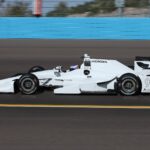 |
| Scott Dixon |
SCOTT DIXON: You know, typically they're the same as far as when you do make these changes. I think it's definitely a polar opposite or polar difference between how manufacturers — these two manufacturers at least run their program. You know, for me it's a lot of familiar faces. As a team we've achieved a lot with HPD and Honda, so it's nice to be back working with a lot of those people, and as I said, they run the program vastly different. So I think the program in itself actually fits our team a little bit better, but you know, we'll have to see. Obviously performance is what you really look for. I think this year is probably the hardest time to do that transition just for the sheer fact that we almost have no off-season testing with four days now in a stagnant year of development, ourselves and AJ Foyt are probably the only two teams that are on a very steep learning curve trying to figure out what the other side has had for two years.
There's a lot to learn, a lot to take in. It's exciting, it's a new challenge, and definitely happy to be behind the No. 9, and we'll see what we can get this season.
Q. Going back to your victory here last year, you led the last 155 laps. Post-race, most of the drivers talked about hard to pass, too much downforce, and you were pretty confident in your statement saying that for the first year you thought things went pretty well but that IndyCar would be better here the second time around in terms of the entertainment value of the race with the aero kit freeze and so forth. Do you still remain confident of the showbiz value of the race?
SCOTT DIXON: I think it'll be better. It's always a fine line and something that's very tough to achieve and takes multiple attempts, I think, at doing it. Right now is a very tough time, too, because this is a non-development year and everything has stayed stagnant, it's very hard for Honda to change any of the parameters because this is — basically nothing is meant to change.
I expect larger changes for next year when we go to a single aero kit configuration, and because next year IndyCar will have the power over the whole car. Right now it's very tough because the parameters that they use, it's very difficult to make an equal change for both.
There has been some smaller changes. Obviously I think Firestone brought a different tire here, too. Right now for me it actually felt like the track grip was up over last year, so that's kind of interesting. Not sure why we're kind of getting that read yet. But to be honest, right now I couldn't tell you either way. We're doing what we can as the drivers to make the show better, and we'll have to wait and see whether it turns out that way.
Q. Could you tell me, do you feel the drivers in the IndyCar organization realize the importance of improving the showbiz value of the race in terms of trying to build the audience in this market of a second year of what may only be a three-year window to succeed?
SCOTT DIXON: Yeah, it's paramount, and there has been some heavy discussions, and not just for here but for a lot of different places. But there's a lot of pieces to the puzzle. It's never that easy just to make one change. In that moment you're going to annoy or anger somebody.
I think IndyCar in the off-season have done an amazing job of going to these tracks, testing configurations. It might not be — the changes as quick as we would like to see, but there's also got to be a methodical change period for both. I find next year it's going to be a lot easier to make these changes. It's just right now in a stagnant year, it's kind of tough. But still, in the off-season they've made some pretty good tests and adjustments and are working in the right direction. We'll just have to see how it works out.
Q. How temporary is the all-white driver suit?
SCOTT DIXON: You don't like it?
Q. I'm just saying how temporary is it until you start having some signage on it?
SCOTT DIXON: That's above my pay grade, man.
Q. And other than I think a couple of years ago when you had a white Target driving suit I believe in Indy or somewhere like that, it's always been red. When is the last time that you've had a non-red driver suit other than the aforementioned time?
SCOTT DIXON: Well, if you count paint schemes and stuff there's been plenty of different colors and white ones. Not this plain, but it'll change before the season starts.
Q. Scott, I guess it would be logical to expect that you guys with the changes would be better in the second half of the season with some experience and work and what have you. Are you confident you can come out of the gate pretty quick and do well in these first few races?
SCOTT DIXON: That's the goal. You know, whether it plays out that way, we'll have to wait and see. But there's — when you're racing a competitor, you have a pretty good understanding of your analysis of where they stand, with where they struggle, where you're better, et cetera, et cetera. So going into this we kind of knew the areas that we were probably going to be on the back foot some and better at others.
I think the off-season for us, to be honest, has been a really good reset with the manufacturer. I think last year as a team we made a lot of mistakes, a lot of small mistakes that we didn't get the small things right first, which gave us ultimately the worst championship that we've had in probably about 12 years. We had great speed throughout the year, but finishing sixth in the championship is not something that we take too lightly.
You know, as I said, it's really hard to gauge. There's areas that we think we're going to be fast and good, but there's areas that as a team we needed to work on, and too, with the manufacturer changing configuration, we might not be at best, as well.
Q. How do you like the fact that there's the same four drivers year to year, whereas — does that help to have that bit of continuity, at least, when there's been one or two changes off and on in recent years?
SCOTT DIXON: Yeah, it's always nice to have the same lineup, you know, and I think with TK, it's been good to work with him for the last two seasons and going into a third. That kind of longevity between him and myself at least, I think you start to get some good patterns of if the 9 car does one thing, the 10 should do this, et cetera, et cetera, which is something that we had a really good sort of platform with Dario when he was in the 10 car. And then with Max's second year, expect to see some big improvements, and I think he's starting to get the flow of it. He was a little unsure of the street courses in IndyCar for a while, but it's definitely taking a liking to those now, and Charlie definitely was strong throughout last year, too. Yeah, I guess the short answer is it's nice to have the same lineup.
Q. The track will have the same layout next year's race, but for the IndyCar race in 2019 everything is going to change, the start-finish line, over there coming out of Turn 2. How much is that really going to change the style of restarts at this track?
SCOTT DIXON: Yeah, it'll be quite interesting, just because of trying to — obviously with the restart zone and stuff is going to be, it could be pretty tough. But it could also open it up a little bit instead of all barreling down into Turn 1. I don't know. The short answer to that is I'm not really sure how it's going to change our racing, whether it will at all. But yeah, I think it's definitely exciting to see Phoenix International putting in all the money and going through the transition, updating the facility. Definitely everybody is excited about that.
Q. Did you think the track needed an upgrade?
SCOTT DIXON: No, I think it wasn't — depends on some of the other places, too, you know. But no, I think this facility — obviously much hasn't changed since I first came here in maybe 2000 or something, or '97 maybe, '98. It's good to see it going through an update.
Q. You talked earlier about the changes to the cars being made to make this a little bit racier. How much are track conditions going to play into that? I know we've gone to some races where if the weather had been different the race would have been completely different. How much does that play in here versus other tracks?
SCOTT DIXON: Yeah, I think here, typically the conditions are pretty similar. We're going to see a pretty big swing, obviously, from today to tomorrow with the ambient, at least the temperature, which will be interesting. But I think from when — from now to when we come back, I don't think there's going to be a big shift. I think on some of the superspeedways you see more of a shift in how the race plays out just because you're in such low downforce levels that swing of a few degrees ambient makes a big difference to overall grip and degradation, too, throughout the race.
Here, you know, you're pretty high on downforce, so it's a much smaller shift.
